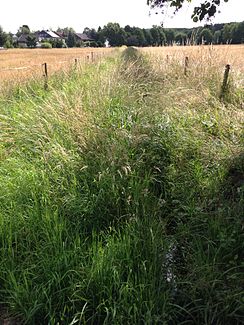Alaunbach (Vilicher Bach)
| Alaunbach | ||
|
The Alaunbach on Glückstrasse, looking east. |
||
| Data | ||
| location | Bonn , North Rhine-Westphalia , Germany | |
| River system | Rhine | |
| Drain over | Vilicher Bach → Rhine → North Sea | |
| source | South of the primary school Holzlar 50 ° 44 ′ 31 ″ N , 7 ° 10 ′ 5 ″ E |
|
| Source height | 86 m above sea level NHN | |
| muzzle | In the Vilicher Bach (Siegburger Strasse) coordinates: 50 ° 45 '3 " N , 7 ° 9' 14" E 50 ° 45 '3 " N , 7 ° 9' 14" E |
|
| Mouth height | 62 m above sea level NHN | |
| Height difference | 24 m | |
| Bottom slope | 9.6 ‰ | |
| length | 2.5 km | |
| Catchment area | 1.7 km² | |
| Left tributaries | Teufelsbach | |
| Big cities | Bonn | |
|
The Alaunbach on Marktstrasse, Bonn. (Pützchens Market) |
||
The Alaunbach is a left tributary of the Vilicher Bach in Bonn , Beuel district . Its total length is 2.51 kilometers and its catchment area is 1.7 square kilometers.
course
The stream is heavily influenced by human activity , especially in its lower section in the industrial area of Pützchen and in the settlement area of Bechlinghoven . Suitable riparian trees are rarely found. The stream areas above the allotment gardens “Am Rehsprung” are closer to nature.
Overall, the stream can be described as poor in species and individuals.
Originally the brook flowed from the source area on the Hardt between Holzlar and Niederholtorf directly into the Mühlenbach, which is also used for drinking cattle, probably along Hardtweiherstraße at the former mill pond there. After resident complaints, the section up to the confluence of the Teufelsbach was, according to an agreement brokered by the Mayor of Vilich from the year 1822 between farmers from Bechlinghoven and Holzlar and the mountain master Leopold Bleibtreu "for himself and as chargé d'affaires of the mining and smelting union on the Hardt" by Leopold Remain faithfully laid out as a "drainage ditch" to accommodate the " vitriolic outflows from Rothenberg" and the sewage from the two alum huts. The Alaunbach now served as an open sewage ditch for the harmful sulphate, i.e. sulfur-containing wastewater from the slag from Alaunhütte II, while the Teufelsbach collects that from the heaps of Alaunhütte I (on Pützchens Chaussee); In addition, the Alaunbach absorbs the seepage water, which is reddish-brown due to iron compounds, and which escaped from the clay and lignite deposits that were also previously mined there. The area from Hardtweiherstrasse is still (partially) visible from this sewage system.
Individual evidence
- ↑ a b German basic map 1: 5000
- ↑ a b Bach Development Plan 2008 , City of Bonn (PDF; 1.65 MB)
- ^ Rudolf Cramer, Hermann Thiebes: The Honschaft Holzlar, Bechlinghoven and Kohlkaul with their wisdom from 1646. (= studies on the local history of the Bonn-Beuel district. Issue 28). 1994, ISBN 3-922832-10-5 , pp. 89-90. Quotations from the reproduction of the agreement there, p. 89.
- ↑ Cramer, Thiebes, see previous footnote, p. 90

